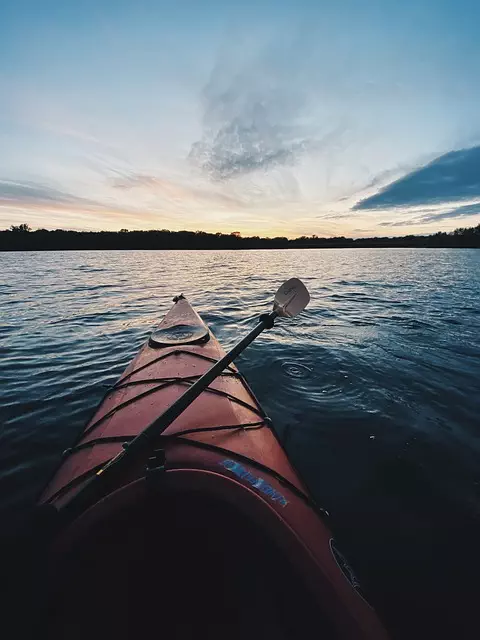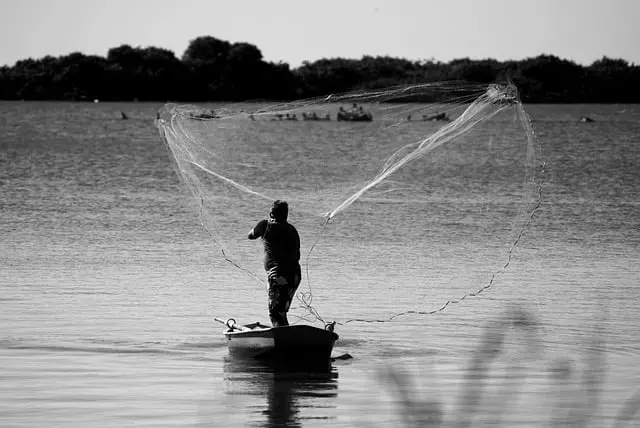When selecting a fishing kayak, prioritize one that offers ample storage solutions tailored to your gear needs and paddling preferences. The Best kayaks for fishing come equipped with dry hatches, tackle pockets, and additional customizable mounts for rod holders and electronic devices. Look for features like bungee nets, D-rings, and integrated tracks or rails that allow you to attach extra gear without overcrowding the kayak. Balance is key; larger kayaks offer more space but may affect maneuverability, so choose based on your intended environment and the type of fishing you'll be doing. Whether you prefer a sit-on-top for easy access or a sit-inside for a drier experience, ensure that your chosen kayak has the storage capacity and organization to keep all your gear within reach without compromising on stability or performance on the water. This will enhance your fishing kayak organization and overall angling experience.
When embarking on a fishing expedition from the serene vantage point of a kayak, ample storage is not just a convenience—it’s a necessity. This article navigates the critical aspects of selecting a fishing kayak with superior storage solutions, ensuring your gear remains dry and easily accessible. From key features to consider, top models with innovative compartments, and strategies for maximizing space, we cover it all. Additionally, we delve into essential gear for effective storage, the designs and materials enhancing modern kayaks, and tips for organizing your vessel for optimal efficiency and accessibility. Whether you’re a seasoned angler or new to kayak fishing, understanding how to choose the right kayak based on your storage needs is paramount to a successful outing.
Understanding the Importance of Adequate Storage in Fishing Kayaks

When venturing out on the water in a fishing kayak, having ample storage compartments is not just a convenience—it’s a necessity. Anglers rely on these vessels to transport their gear efficiently and securely. A well-designed fishing kayak will feature various sized and positioned storage options to accommodate tackle boxes, extra rods, safety equipment, and personal items without compromising the kayak’s performance or stability in the water. The strategic placement of these compartments allows for easy access to essential tools while maintaining a low center of gravity, which is crucial for balance, especially when navigating through narrow waterways or casting a line. Moreover, sealed hatches and dry storage options protect sensitive electronics like fish finders from the elements, ensuring that every fishing trip is optimized for success. The integration of thoughtfully designed storage solutions in fishing kayaks enhances the overall experience by providing anglers with the peace of mind to focus on what matters most—catching their prized fish. It’s imperative to consider the type and volume of gear you plan to take along, as this will influence the choice of a kayak that offers sufficient and well-thought-out storage capabilities to meet your fishing needs.
Key Features to Look for in a Fishing Kayak with Ample Storage

When selecting a fishing kayak that boasts ample storage, it’s crucial to consider several key features that will enhance your angling experience and ensure your gear remains secure and accessible. Firstly, look for a kayak with multiple storage hatches or compartments designed to safeguard your belongings against water intrusion. These hatches should be strategically placed for easy access to fishing equipment, snacks, and personal items while on the water. The storage compartments should vary in size to accommodate both large and small items, with at least one dry storage area where you can keep valuables or electronics like GPS devices or cameras.
Additionally, a well-designed fishing kayak should feature a large rear storage tank well, which is ideal for soft-sided coolers, extra paddles, or bulky gear. The tank well’s size and shape allow you to secure items with bungee cords or tie-down straps, providing peace of mind that your cargo will remain in place even during turbulent water conditions. Moreover, the presence of molded-in rod holders, particularly in the rear, can be beneficial for hands-free fishing or trolling. A kayak with thoughtfully integrated storage solutions not only maximizes space but also enhances the overall stability and performance on the water.
The Best Fishing Kayak Models with Superior Storage Solutions

When venturing out on the water for a day of angling, ample storage is a necessity to ensure gear remains accessible and safe. The best fishing kayak models are equipped with superior storage solutions that cater to every angler’s needs, whether it’s for keeping your paddles, tackle, or catch secure. Models like the Hobie Mirage Pro Angler 360 and the Old Town Predator MX are exemplary in this regard, featuring a combination of sealed hatches for electronics and valuables, as well as open storage areas for quick access to your fishing essentials. These kayaks boast thoughtfully designed compartments that can accommodate everything from extra lines and lures to GPS units and dry bags. The Hobie, in particular, offers a Kayak Hero Lowrance Ready Compartment, which integrates seamlessly with a Lowrance fishfinder for anglers who rely on sonar technology. Meanwhile, the Old Town Predator MX comes with a large rear storage platform, perfect for storing your catch or additional gear, and a front hatch that seals to keep contents dry even in choppy waters. These superior storage solutions are what make these fishing kayak models stand out among their peers, ensuring that both the angler’s experience and equipment are well-protected on the water.
Strategies for Maximizing Space in Your Fishing Kayak

When embarking on a fishing expedition from your kayak, efficient use of space is paramount for both comfort and functionality. To maximize storage in your fishing kayak, it’s essential to strategically organize gear and equipment. Start by utilizing the designated compartments effectively; place items you may need immediately or frequently in the most accessible areas. Keep often-used tools like pliers, knives, and extra line within easy reach. Dry bags are a versatile solution for storing bulkier items like rain gear or an extra paddle, as they offer both weatherproofing and organizational benefits. Secure these bags with bungee cords or cargo nets to prevent them from shifting during your journey.
Additionally, consider the vertical space available in your kayak. Attach clips or pockets to the sides for additional gear storage. Lightweight and waterproof containers can be strapped down to keep your catch or other perishables fresh. For items you rarely need, such as a first aid kit or a spare paddle, use the rear hatch or bulkhead compartments where they won’t interfere with your paddling but are still protected and easily retrievable in case of necessity. Remember to balance your kayak by distributing weight evenly and not overpacking any one compartment. By thoughtfully organizing your fishing kayak’s storage, you can enhance both your angling experience and safety on the water.
Essential Gear and Equipment for Effective Kayak Fishing Storage

When embarking on a kayak fishing adventure, having ample and well-designed storage compartments is key to organizing your fishing gear efficiently. A fishing kayak equipped with dry storage hatches allows anglers to keep sensitive electronics like fish finders and smartphones safe from the elements. These hatches are typically found at the kayak’s front and rear, providing secure and watertight spaces for critical items that you don’t want to lose overboard. Additionally, bungee cord rigging on the deck offers quick access to frequently used gear like extra paddles or a landing net, while also accommodating bulky items that wouldn’t fit inside the hatches. Strategically placed rod holders are essential for anglers who wish to troll or keep their rods ready without occupying valuable storage space. The design of the fishing kayak should prioritize a balance between open and closed storage options to cater to both dry and immediate access needs. Paddle parks, gear tracks, and adjustable mounts further enhance the versatility of the kayak’s storage capabilities, ensuring that each angler can customize their fishing kayak to fit their unique gear requirements for an effective kayak fishing experience.
Innovative Storage Compartments: Designs and Materials Used in Modern Fishing Kayaks

Modern fishing kayaks are equipped with a variety of innovative storage compartments that cater to anglers’ needs for both space and accessibility on the water. These compartments are thoughtfully designed to protect gear from the elements while ensuring it remains easily accessible during a fishing expedition. The hulls of these kayaks often feature integrated hatches with watertight seals, allowing for secure storage of valuables like wallets, keys, and electronics. Additional compartments are strategically placed for quick access to tackle, which is essential when you need to switch lures rapidly in response to changing fish behavior.
The materials used in these storage solutions reflect the demands of durability and buoyancy. High-density polyethylene (HDPE) is a common choice due to its resistance to water, UV rays, and chemical exposure, ensuring that the contents remain dry and protected over time. Some kayaks incorporate molded-in storage channels that are both aerodynamic and functional, reducing drag while accommodating longer rods or nets. Advanced models may also feature breathable mesh pockets and cargo nets for larger items, which not only provide ample space but also allow for ventilation and quick organization. These features collectively enhance the fishing experience by providing anglers with a versatile and user-friendly platform from which to navigate and fish effectively.
Tips for Organizing Your Fishing Kayak for Efficiency and Accessibility

When venturing out in a fishing kayak, organization and accessibility are key to an efficient fishing trip. To make the most of your time on the water, it’s essential to strategically place your gear so that everything you need is within arm’s reach and organized in a way that minimizes movement and potential disturbance to your surroundings. Begin by assessing the storage compartments on your kayak, which are typically designed with fishing in mind. Utilize the dry hatches for items that must remain dry, such as electronic devices or important documents. Place frequently used gear, like pliers, line cutters, and lures, in the easily accessible tackle pockets. Keep your paddle securely stowed but within reach to maintain mobility without hindering your fishing line.
To further enhance organization, consider using bungee nets or straps for bulky items like rain gear or extra paddles. These can be attached to the deck rigging or scupper holes. For soft goods like jackets or sun protection, use the D-rings behind the seats. Ensure that your cooler is positioned between your feet and in front of the center console to balance the kayak and keep your catch chilled. Labeling containers for small items like hooks, sinkers, and bobbers can save time and prevent losing these critical components. Lastly, remember to distribute weight evenly across the kayak to maintain stability on the water, which is crucial for safety and efficiency. By carefully planning and utilizing all the storage options available on your fishing kayak, you’ll be able to focus more on what matters most—landing that big catch.
How to Choose the Right Size and Type of Fishing Kayak Based on Your Storage Needs

When selecting a fishing kayak that meets your storage needs, it’s crucial to consider the size and type of kayak that will best accommodate your gear and equipment. A fishing kayak with ample storage compartments is essential for longer excursions where you need to carry more tackle, bait, and personal items. The size of the kayak should align with the amount of space you require; larger kayaks offer more room for storage but may be less maneuverable in tight spaces. Paddlers with extensive gear might opt for a longer, narrower kayak that provides greater hull speed and tracking ability, alongside additional storage options. On the other hand, those who prefer shorter trips or need to navigate through narrow waterways might choose a smaller, more compact fishing kayak that still offers sufficient storage for essential items.
The type of storage compartments also varies between models; some kayaks feature open storage areas, while others come with sealed hatches for keeping electronic devices like fish finders or stowing valuables safely away from the elements. Additionally, built-in rod holders and accessory eyelets further enhance the functionality of a fishing kayak’s storage capabilities. When choosing between sit-on-top and sit-inside models, consider your personal preference for accessing stored items and the types of waters you’ll be navigating. Sit-on-tops typically offer more open deck space for gear storage but can collect water on the deck; sit-insides may have less exposed storage but can provide a drier experience. Regardless of the model, ensure that the kayak has enough storage to fulfill your fishing needs and that it matches your paddling skill level and the conditions you’ll encounter on the water.
